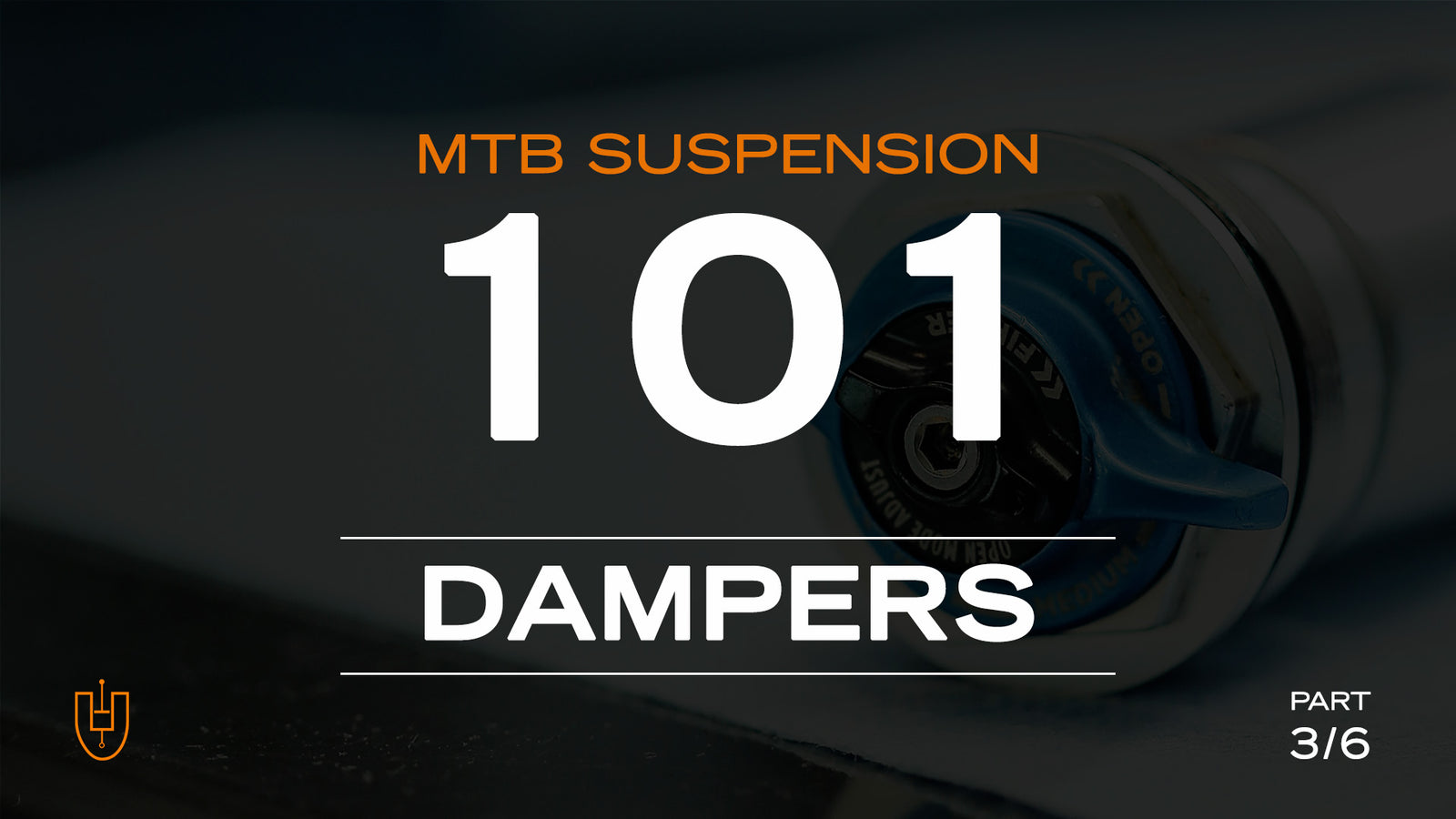MOUNTAIN BIKE SUSPENSION 101: Dampers (Part 3 of 6)

What is a damper?
Springs, whether it is a physical coil spring or air being compressed in an air spring – would naturally bounce back with the same energy that was originally put into them, much like how a pogo stick works. Though the objective of a pogo stick is to be launched several inches or feet into the air, that is not the case (we would hope...) when you encounter an obstacle on a mountain bike. This is where dampers come in. Dampers control the spring’s oscillations and movements by dissipating energy, so the energy stored and released by the spring is not thrown back at you immediately and uncontrollably. Squish, yes. Bounce, no.
Compression and rebound describe the main movements in suspension dampers:
|
Compression is the first movement where the shock or fork is compressed from obstacles encountered on the trail. |
Rebound is the second movement where the fork or shock returns to its original position |
|
|
|
These movements are happening continuously while you are riding (even on the smallest bumps).
When you ‘bottom out’, it means the fork or shock has reached maximum compression.
Virtually all suspension on modern mountain bikes have a damper, with the exception of low end suspension bikes sold at Walmart. The quality of the damper, and mainly its adjustability, is a large part of what you are paying for when you buy a fork or shock. ‘Higher end’ dampers offer many adjustments to suit a rider’s needs: low & high speed compression, as well as low & high speed rebound adjustments. Having all these adjustments can be daunting, especially if you have no idea of what you are doing.
How does it work?
A discussion of damping systems or types of dampers can get complicated really quickly. For the purpose of this 101, most dampers in forks and shocks, in its simplest form, are controlled by oil being forced through small holes, known as ports, orifices or apertures.
Larger holes/ports = Oil flows through more easily, so the suspension moves more freely.
Smaller holes/ports = Oil flows through with more resistance, so the suspension moves less freely.

When you adjust your compression or rebound knobs, you are directly or indirectly closing or opening these holes. The same rules of ‘righty-tighty’ (to close) and ‘lefty-loosey’ (to open) usually apply.
Having a fear of adjusting or even touching compression and rebound dials is extremely common. Many riders worry that if they change things, it will result in some highly unpredictable behaviour that causes them go OTB (over the bars) or otherwise lose control of the bike. In practice, for most riding (other than hitting jumps), making adjustments to your rebound or compression damping does not have anything like that extreme of an effect - if you have your rear shock's rebound fully fast and feeling like a pogo stick and the fork's rebound set up fully slow so that it won't return until next week, that might actually happen, but for now, don't be afraid to make adjustments to your dampers.

What is high and low speed?
High-speed and low-speed takes compression and rebound, and splits it into two zones. The "high" and "low" do not necessarily mean the speed at which you are traveling, but rather the speed at which the damper is rebounding or compressing. For example, you could be rolling super fast down a smooth road, but only be engaging your low-speed compression and rebound, or moving at a moderate speed through very sharp, square-edged bumps which may be causing the suspension to move quite fast. For the purposes of explanation, we will break down compression damping first as these concepts will also apply to rebound.
The high and low speed compression circuits are separate flow paths that exist simultaneously and in parallel, kind of like having two checkout aisles at the supermarket - oil (or people) can go through either one if both are open, but if only one is open, everything has to go through that one, which means more people waiting at the checkout (or greater resistance to oil flow). The amount of resistance, and which oil flow paths are in use at the time, depends primarily on how fast the damper is compressed.

In most cases, the low speed adjuster simply adjusts the size of a hole in the low speed circuit (circuit in this case meaning "flow path") that oil has to flow through, by partly blocking the hole.
The high speed adjuster can be a bit more complicated mechanically, but their job is simple enough. High speed circuits basically have a variable flow area, meaning that they can have something like a self-adjusting hole size, that gets bigger as the speed (and therefore damping force) increases. This means that the damping force can be controlled by allowing more area for oil to flow through as the damper speed increases.
While the damper is moving slowly, most or all the oil is moving through the low speed adjuster, and little or none is moving through the high speed circuit, which is controlled by the high speed adjuster. However, once it has to move faster such as on a hard landing from a jump or drop, that small low speed orifice is not able to allow enough oil through quickly enough, so the increase in pressure forces the high speed circuit to open, by pushing a shim stack or preloaded spring back away from a hole that was previously covered. This is how we can have two separate, parallel damping circuits that are adjusted separately for different scenarios.

By increasing the low-speed damping, you are effectively reducing the size of a hole that oil flows through so that the oil will need to move quicker through that smaller hole, which increases your damping force, or resistance to motion. By decreasing the low-speed damping, you are allowing the oil to move with less resistance, meaning the fork or shock can move more freely at low speeds.
This explanation is basically true for all high-performance hydraulic dampers, whether we're discussing the compression damping or the rebound damping. Just knowing how it works doesn't automatically tell you exactly what adjustments to make, but it helps understand exactly what your damper does differently when you make an adjustment, which in turn offers you more insight into what adjustments are likely to achieve the kind of effect you're looking for.
Is it damping or dampening?
The answer to the one question that nobody asked...
Damper / damping - absorbs energy
Dampener / dampening - makes things wet
Next:
Part 4/6 - Understanding Rebound Damping



